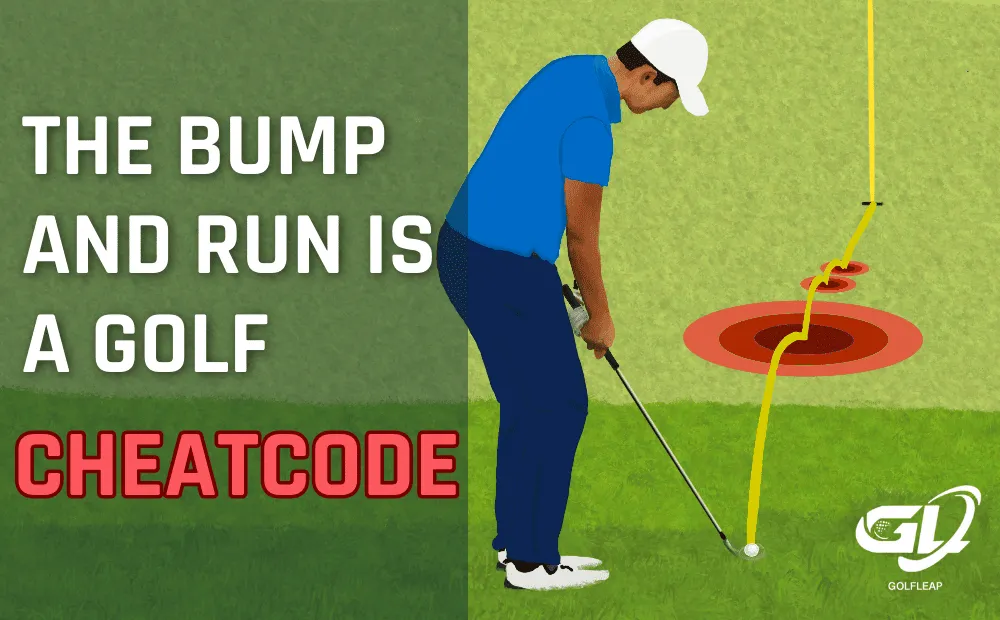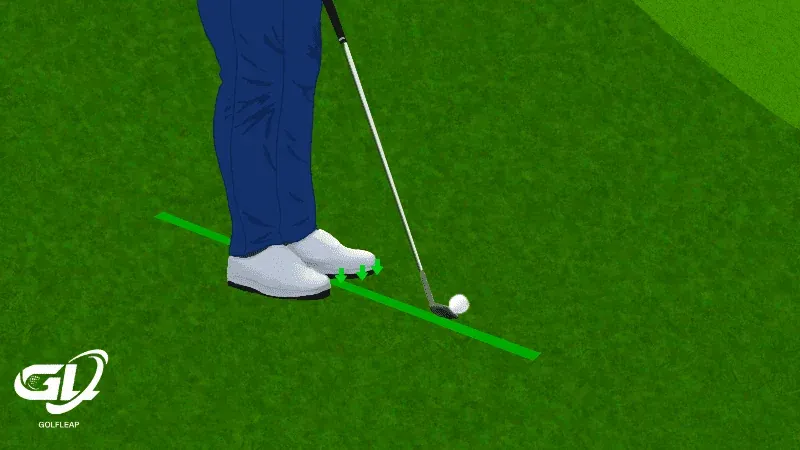
Your short game is the biggest contributor to lowering your score. This is the universal rule for any handicap level. Master this, and you’ll be better than most at golf.
However, we know just how hard it is to get the ball as close to the hole consistently for every type of green condition. So having a single chipping technique with a wedge just won’t cut it.
The bump and run golf shot (sometimes referred as the chip and run) is a shot that utilizes a less lofted club, like an 8-iron or 9-iron, to keep the ball low and rolling along the ground. As a result, it has become the most popular ‘chipping-styled’ alternative for tackling uphill greens or when your chipping the ball against the grain. Personally, the bump and run is one of the biggest cheat codes I have ever discovered in golf.
It’s also perfect for navigating tight lies, maneuvering around obstacles, and maintaining control in windy conditions. By understanding when and how to use this technique, you’ll be able to elevate your short game and see a noticeable improvement in your overall performance. Let’s dive into the world of bump and run shots, and discover how this simple yet powerful technique can transform your golf game.
What is a Bump and Run in Golf?
The bump and run is a low-trajectory golf shot where you “bump” the ball onto the green and let it “run” towards the hole. It differs from a chip shot, which has a higher trajectory, has more backspin, and lands softer, as the bump and run spends more time on the ground, giving you better control over its path and speed.
When to Use the Bump and Run
The bump and run is most effective in situations where:
- The green is flat, and where there are no major obstacles, such as bunkers, between you and the hole.
- The green is on an uphill slope from where you’re hitting the ball
- You need to hit the ball against the grain of the green
- The lie is tight (more on what this is later), requiring solid contact with the ball
- When you skull your chips often
When to Not Use the Bump and Run
Trust me, you’ll get addicted to this thing. I remember trying to bump and run when my ball was wedged in a pile of fluffy sand when I first started using it (definitely not a good idea). But there’s a place for everything, and here’s where you should not use the bump and run:
- When the green is downhill from where you’re hitting
- The hole is close to the edge of the green from which you’re hitting from
- When the greens are fast (in this case chip it with a wedge)
- When you’re ball is buried deep in the sand of the bunker (yes, I know…)
Benefits of Mastering the Bump and Run
Improved Short Game Consistency
Consistently executing the bump and run will enhance your short game, reducing the likelihood of skulled chips or fat shots. It’s just so easy to hit the bump and run, skyrocketing your consistency compared to chipping. This, with practicing your speed control will make it so easy to get your ball 1-putt away from the hole in most golf courses.
Better Trajectory Control
The bump and run allows for better control over the ball’s trajectory because unlike chipping, its feel is most similar to hitting with your irons compared to when you’re chipping. With this shot, what you see is what you get. But with chipping often golfers tend to have less of an idea of how the shot will play out when you hit with a higher-lofted wedge. Overall, with more consistency and familiarity with the style of the bump and run, you’ll be able to navigate challenging greens more effectively.
Lower Scores
Golf is a game of 100 yards, and even more so within 50 yards. Mastering the bump and run provides an advantage around the greens and dramatically improves your short games. This results in fewer three-putts and more playable lies.
For instance, I broke my personal best at one of my favorite golf courses with this shot (My personal best at that course was +15, now it’s +12).
Ease of Execution
The bump and run is relatively easy to hit, just think of it as a more aggressive putting stroke. Plus, the feel of the shot at impact is very similar to hitting you with irons. I promise you that with some practice, you’ll make this shot a valuable addition to your golfing toolkit and start seeing lower scores. But remember, the challenge is not if you can hit the ball, with the bump and run its relatively straight forward, but how well you can control the speel of your ball as it lands on the green.
More Fun
I don’t want to sound cheesy, but you are here to have fun. And ultimately, hitting better short-game shots to end a hole well is much more fun than thinning the ball past the green or skulling it 2 feet forward. When you start having more fun, you’ll get more pumped to play more golf which will make you a better golfer (can’t tell you how much I agree with this).
In summary, the bump and run is an essential shot to master for golfers looking to improve their short game. Its simplicity and effectiveness can help reduce strokes and make golf more enjoyable and accessible for everyone. So, don’t hesitate. Start practicing your bump and run and watch your score drop like a waterfall.
How to Hit a Bump and Run Golf Shot
Club Selection
Choosing the right club is essential for mastering the bump and run shot. Your go-to clubs for this shot should be a PW, a 52-wedge, a 7-iron or an 8-iron. The club you choose depends on how much roll you want—the more roll, the longer the irons/ the less loft you get. Remember, it’s crucial to pick an iron for this shot or at most a pitching wedge or gap wedge (52 degrees); don’t attempt a bump and run with your driver or any other wood categories (fairway woods and hybrids).
Bump and run shots use less lofted clubs to achieve the desired result, but too much loft and you’ll be skidding through the ground and rolling the ball past the hole.
The Bump and Run Setup

Setting up properly is key to executing a successful bump and run shot. Start with a narrow stance and distribute your weight towards your lead foot. Position the ball towards your trail foot to ensure a cleaner contact with the ground. Your hands should be slightly ahead of the ball, with a slight shaft lean to give the shot more roll and a chance for a more consistent impact. Finally, I personally prefer to put more weight on my lead foot so that i really close the loft at impact, prevent me from skulling the ball or thinning it, creating that “bumping” effect.
The Bump and Run Swing
The swing for a bump and run shot is quite different from a regular golf swing. It resembles a pendulum-style swing, similar to how you would swing your putter.
Start by, keeping your arms straight throughout the swing, and avoid any wrist hinge at the end of your backswing, as the swing arc for the bump and run is not bigger than a full golf swing.
As you make contact with the ball, focus on keeping your wrists locked and arms straight. This will help ensure a smooth, consistent impact and help you execute the perfect bump and run shot. With practice and the right technique, you’ll soon find yourself conquering tight lies and tricky greenside situations with ease.
Here’s a handy video by TaylorMade Golf that featuring Rory McIlroy showing golfers how he hits hit a bump-and-run. The main takeaway is how effortlessly Rory hits it and that’s exactly how you should be hitting the bump and run. Don’t overcomplicate it!
When Should You Do a Bump and Run Shot in Golf?
Tight Lies
Tight lies are situations where there is very little to no grass beneath your golf ball, often occurring on dried patches of grass due to a lack of water. Hitting with a wedge in these conditions can be challenging, as the sandy turf can take away much of the energy from the club, leading to a skulled shot. The bump and run shot is an excellent choice for tight lies because it requires minimal turf interaction, allowing the face to go straight to the ball. This creates better control and more consistent contact with the ball on tight lies.
Tree Trouble
When you find yourself maneuvering around obstacles, such as trees, the bump and run shot can be a real game-changer. In these situations, you’ll often need to hit the ball under the trees instead of over them to get back into play. The bump and run is perfect for this purpose, as it keeps the ball low and enables you to navigate around/ below obstacles with precision instead of needing to pitch over the trees.
Windy Conditions
In windy conditions, controlling the ball flight can be quite challenging. The bump and run shot helps you maintain control, as it keeps the ball low and minimizes the effect of the wind on your shot trajectory (more trees blocking the wind from the ball as compared to when it’s high in the air). By opting for the bump and run in these conditions, you’ll be able to better predict and control the outcome of your shot.
A Lot of Green to Work With
When you have a lot of green to work with, the bump and run shot can be an excellent option for better control. By utilizing the green’s surface, you can roll the ball toward the hole more predictably. However, be cautious when facing downhill greens, as a chip shot may be more suitable in this scenario to prevent the ball from rolling too far past the hole.
By understanding when to use the bump and run, you can add an extra layer of strategy to your game and tackle a variety of challenging situations on the golf course.
Do Pro Golfers Use the Bump and Run
Yes, but not often. Anyone can agree that this shot is valuable, even for the pros. But in most professional tournaments, their greens are glass-like slippery. That’s where chipping onto the greens in these courses becomes more reliable and controllable. I’m sure if the greens at the Masters are slower and not designed like a roller-coaster track, then you’ll be seeing the bump and run more often on TV. Plus, these guys are absolute beasts at chipping, so why not just chip?
How to Practice The Bump and Run
Like I said, don’t overcomplicate the shot. It’s just a more aggressive version of a putting stroke with an iron-styled grip. Instead, to practice this shot, focus more on speed control.
Go to the range and head over to their practice greens. From there, start bumping. Bump from lies and towards different holes to get a good idea of how much speed you generate with the 7-iron and 8-iron.
Difference between the Bump and Run Vs. the Thai Spinner
Unlike the Bump and Run, the Thai spinner golf shot is used for grainer greens and creates a high-spinning but low-flight wedge shot compared to a bump and run’s lower spin. Additionally, the Thai spinner uses a higher lofted wedge (56 degrees at least) while the bump and run uses shorter iron and can be played beyond greenside. That said, both are short-game shots that have their element in helping with distance control. I encourage you to practice both techniques, but I would still prioritize the bump and run.
What Next?
And we’re done! You might be itching to try the bump and run right now, because it sounds too good to be true, but I’m telling you… I was just as shocked by how quickly I started incorporating this shot into almost every aspect of my short game.
It’s so easy to learn too and effortless when you understand how much roll your generating with each club and the amount of power you put into it. So don’t wait, go practice at your nearby range greens!
May the course be with you

